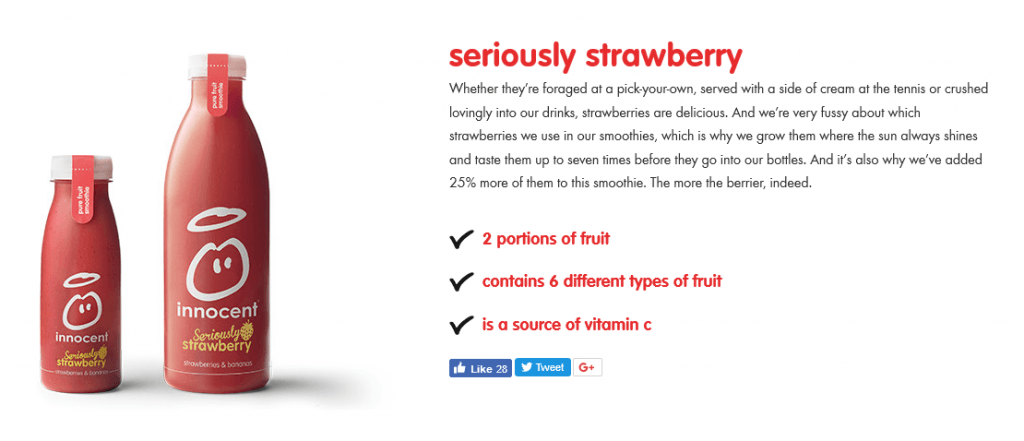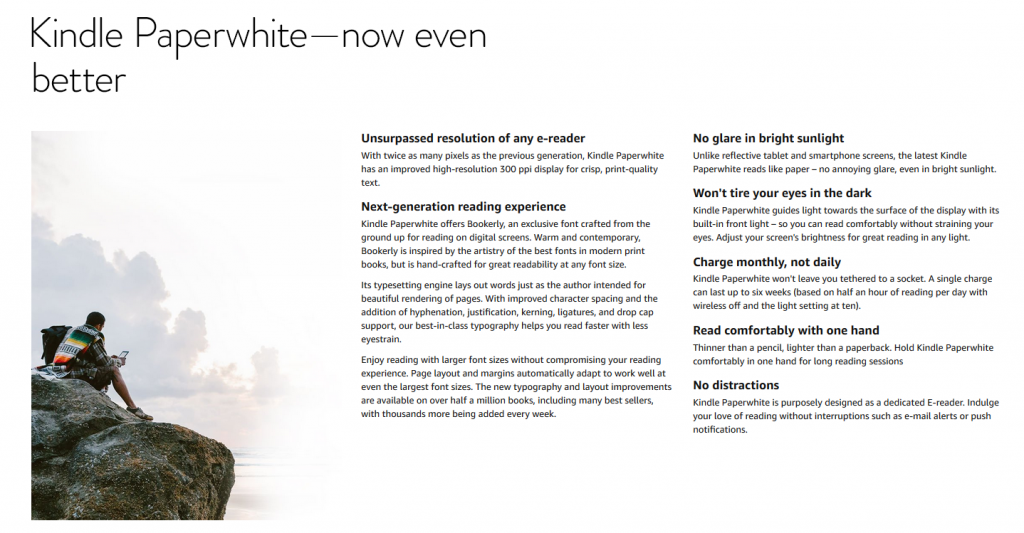You’ve done the hard part and attracted a potential buyer to your product page. Now, you must convince them to click the “Add to cart” button.
One thing that will help convince them to make a purchase from you is an effective product description. Despite being one of the most important conversion factors when it comes to online shopping, a product description is one of the most neglected areas.
According to one study, 20% of all purchases fail because of missing or unclear product information.
What is a Product Description?
A product description isn’t just describing your product — it needs to sell it. It should illustrate what the product is, why it’s worth buying and include details around the features and benefits of the product.
The best descriptions directly focus on the buyer and include language they would use. Imagine you’re in a store talking to the customer face-to-face and translate this into an online conversation; this will resonate with them better. Instead of just listing the features, you need to highlight the benefits for the buyer. In other words, sell an experience, not a product.
With that in mind, here are seven top tips for writing winning product descriptions.
1. Know Your Target Audience
Before you write your description, you need to understand your buyers. Learn about where they are coming from, what gender they are and more.
Check your reviews to see what they’re saying about you and your product. YouTube and other social media platforms are great sources for finding out how customers use your products and what they’re saying about your company.
Here’s a great product description from Innocent about their Seriously Strawberry smoothie. It highlights the drink’s key features with three clear bullet points and sells the drink with a product description that will resonate well with its target audience.
2. Put Yourself in the Buyer’s Shoes
It’s useful to put yourself in the buyer’s shoes and browse as you expect they would.
Ask yourself questions like:
- What did you like/dislike?
- How does it compare to other listings?
- Why did or didn’t you make the purchase?
3. Do Your Keyword Research
Keywords are relevant search terms that allow people to find products. To optimize your product listing, it’s useful for sellers to know what keywords they are targeting and ranking for. You should only use keywords that are relevant, and they should be added to appropriate places within your listing such as the title and product features.
To find keywords, you need to think like a customer looking for your product. You can use tools like the Google Keyword Planner or Amazon to help with your keyword research.
4. Consider Your Language
You’ve probably seen the phrase “excellent product quality” in lots of online product descriptions, which is fine, but as it is overused it has little impact on potential buyers. Sellers aren’t going to state, “average product quality” so it becomes a bit redundant in the mind of a buyer.
Hubspot stated that using certain words can help boost your sales and turn visitors into buyers. The list includes: you, value, do, imagine, see, opportunity and their name.
Companies such as Marks & Spencer successfully use sensory words that refer to taste and sound to produce vivid product descriptions.
Here’s their description for their Belgian chocolate cake, which will leave you salivating!
5. Focus on the Product Features and Benefits
Focus on any technical features and the benefits they bring. Be specific. Product details add credibility and help sell your product.
Check out this great product description from Amazon, which focuses on the features and benefits of its new Kindle Paperwhite.
With phrases such as “unsurpassed resolution” and “next-generation reading experience,” I’m tempted to upgrade myself!
6. Tell a Story
Storytelling isn’t just a popular marketing buzzword; it’s a great way to boost your product page conversion rate.
According to one study, a group of consumers was 5% likelier to choose a bottle of wine with the winemaker’s story over standard tasting notes. Interestingly, they were also willing to pay 6% more for it.
Check out this great product description with storytelling from Laithwaites wine.
If your product description contains a mini-story it will help persuade the customer to make a purchase.
When it comes to telling a story about your products, ask yourself:
- Who made the product?
- What inspired them to make the product?
- What obstacles did they overcome on the way?
7. Use Social Proof
According to a study by BrightLocal, 85% of us trust online reviews as much as personal recommendations and 97% of consumers read online reviews for local businesses.
Buyers are attracted to products that are popular and have a large number of positive reviews.
If you’re a private label seller on Amazon, discover how to get more product reviews.
Amazon Product Description Guide
Not putting time and effort into their product descriptions is a common mistake for new and experienced Amazon sellers alike — and one that is costing them sales. Even some of the bestselling products on Amazon have vague or incomplete descriptions.
The good news is that it’s easy to rectify, using the advice in this post. For all sections, you should follow Amazon’s guidelines and adopt best practices.
An optimized Amazon product listing can convert visitors into customers. People will buy from people they trust, and a good product description can help to build that.
Amazon product listings are composed of three elements: a title, features and the product description.
A title should get people’s attention and get clicks from visitors. Remember: you’re writing for humans, not robots so don’t just keyword stuff. Instead, focus on adding one or two of your top keywords. And, don’t use all caps.
Here’s a good example from Anker for their Bluetooth headphones.
As most people skim when browsing online, use bullet points to state the key features and benefits of your product. They should be specific and no longer than 200 characters.
Plus, ensure you use all of the five points you are allocated, like Anker has below, to show why your product is awesome and better than your competitors’.
Finally, there’s the product description. Remember, the goal of a product description is to explain what the product does and why someone should purchase it.
Not everyone will read it, but some will.
The pen is mightier than the sword, so use this section to explain what makes your product better and how it will enhance buyers’ lives.
- Elaborate on the title and features you mentioned in the previous section.
- Put yourself in the customer’s shoes.
- Consider the use of powerful and emotional words to tell a story about your product and convince shoppers why they need it.
- Include your keywords and use formatting so it’s easy to read.
- Let your personality shine through in your writing.
- Don’t include your seller name, website URL or company information.
Again, here’s a great example from Anker that also includes a high-quality image of the product in use.
Conclusion
So there you have it – everything you need to create a great product description that converts visitors into customers. Product descriptions are a much-neglected part of an Amazon listing so don’t fall into the trap of not giving yours the attention they deserve. And remember, always focus on talking directly to your visitors and addressing their interests or concerns.
—
Social proof in the form of positive reviews is a vital conversion factor. If you’re an Amazon seller looking to get more positive seller feedback and product reviews without the hassle, then you might want to consider automating your feedback management process with FeedbackExpress.
Special offer for StoreYa readers: Use the code “STOREYA10”, and you can enjoy 30 days of Amazon feedback software for free, then get a 10% discount on your first month’s subscription.

Chris Dunne is a huge football fan, craft beer lover and marketing executive at FeedbackExpress, Amazon feedback software and RepricerExpress, Amazon repricing software.
Recommended articles
 Facebook Ads for eCommerce: 16 Strategies, Examples & Tips
Facebook Ads for eCommerce: 16 Strategies, Examples & Tips
 How to Build a Winning eCommerce Ads Strategy
How to Build a Winning eCommerce Ads Strategy
 Google Ads for eCommerce: Everything You Need to Know
Google Ads for eCommerce: Everything You Need to Know
 10X Your Traffic with PPC Management Software
10X Your Traffic with PPC Management Software
Comments
Powered by Facebook Comments











